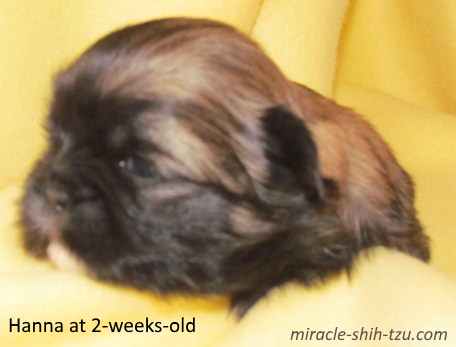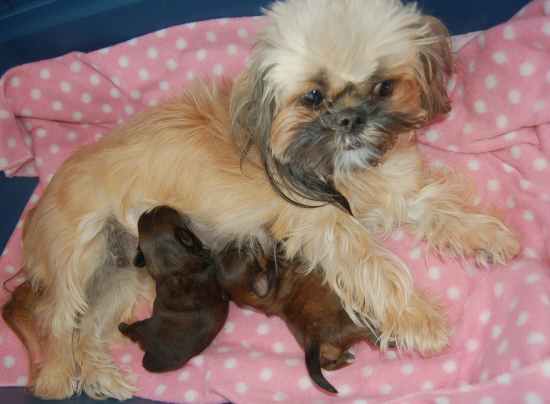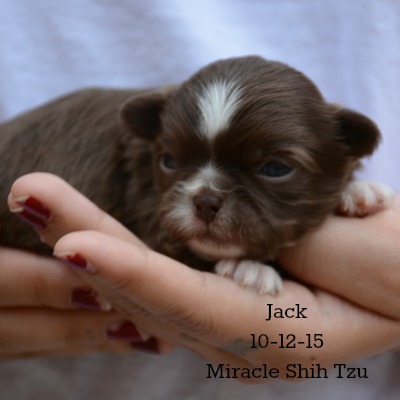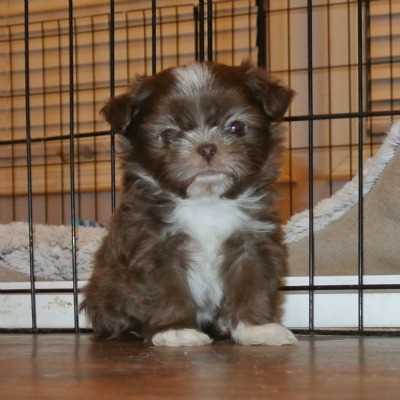- Home
- Coat Colors
- Shih Tzu Hair Color Changes
Shih Tzu Hair Color Changes: Why Those Alterations?
By Janice Jones |Last Updated 05-06-2021
We've watched Shih Tzu hair color changes over the years and it never seems to amaze me how these dogs achieve just beautiful color without the use of exotic hair color dyes or expensive stylists! Meet, Hanna our red-gold Mama as she grows.
Many people are surprised at their Shih Tzu hair color changes that seem to come out of nowhere.
Dark colored hair turning lighter. Lighter haired dogs end up with dark hair. Some hair color fades while others gray.
I have had so many people ask me about these changes that I thought it might be worthwhile to explore each type of change.
 Hanna at 2 Weeks Old
Hanna at 2 Weeks Old Hanna at 2 Years Old
Hanna at 2 Years OldThere is no doubt about it: Shih Tzu hair color changes over time. The most dramatic change occurs from the time the puppy is born until he reaches maturity.
Some of these changes do not really change at all, but rather a dog’s true colors coming through.
Other changes occur due to staining or yeast infections which really is more of a hair discoloration than a real change.
Still others involve an actual genetic tendency that results because the puppy has inherited a graying or fading gene.
Let’s look at each type of Shih Tzu hair color changes, individually.
 Jack at 2 weeks
Jack at 2 weeks Jack at 2 months
Jack at 2 months Jack at 5 months
Jack at 5 monthsShih Tzu Hair Color Changes
When Shih Tzu Hair Color Changes Aren't Real
Shih Tzu Hair Color Changes which are not actual changes.
Often a puppy is born with a rather dark colored coat. As time passes, the coat appears to lighten. Some of these changes do not have to do with genetics but with the actual coat color emerging. It is often difficult to determine what color a puppy will end up being by looking at a 3-day old puppy.
Breeders will first look at the area on the dog under the tail. They will also look at the hair roots. If there is a difference between what is showing at the hair roots and under the tail and the hair on the body, there is a good chance that the adult’s coat color will be that of the hair roots.
For example, a puppy that has a brindle color throughout the coat, but has light gold under her tail and at the hair roots, will end up being gold.
Another twist to this is the black tipping that occasionally occurs in Shih Tzu puppies. They appear very dark, almost black at birth but have light colored hair roots. As they begin to mature, their hair continues to grow.
The ends of the hair are black and the hair closest to the body is light. It almost appears as if someone has deliberately dyed the ends of their hair dark. This can be a stunning look, but it is usually a fleeting experience because when the puppy gets clipped for the first time, the dark ends are cut off and will never grow again.
When Color Changes are Due to Yeast and Bacteria
Red Staining on White or Light Colored Hair can appear to resemble Shih Tzu hair color changes.
Staining is a frequent
occurrence in light colored dogs and has
nothing to do with coat color changes.
Staining can occur anywhere, but it usually develops on the face
(whiskers and beard) under the eyes, paws or around the groin area. There are different theories and reasons for
different type of staining
Mustache and Beard that Turns Red
If staining occurs on the beard or mustache, the cause could be the water the dog is drinking. If the water has a high mineral content, such as iron, the stains result because the dog drinks their water from the bowl and the water dries over time leaving the hair discolored.
If the discoloration is only on the whiskers or beard, one way to reduce the red or orange color is to teach the dog to drink out of a water bottle so that water does not remain on the dog’s fur. Using bottled or distilled water can also help reduce the staining as well.
Using a stainless steel or ceramic bowl can also be beneficial.
Color Changes or Discoloration Under the Eyes
If the staining occurs under the eyes, the likely culprit is a red yeast infection or Ptyrosporin. This could be due to clogged tear ducts which could be opened surgically by your veterinarian.
The shape of the eyelids and the presence of hair irritating the eye can also cause staining to occur. Whitening shampoos, no matter how good there are will not remove these stains. Other products on the market do an adequate job on them, but it does take time.
Other Possible Causes of Shih Tzu Hair Color Changes due to Staining:
- Puppy Teething
- Foods that contain artificial dyes and colors
- Contrary to what you might have heard, beet pulp found in some dog foods will not cause tear staining. The powdered form used in dog foods and treats is actually white and not the normal red color found in beets humans may eat.
Red or Orange Discoloration on Paws, Groin
Redness on the paws often results because the dog is licking or biting at their legs. It is important to know what is causing their discomfort. Is there something stuck between their paw pads?
Has the hair between the pads allowed to grow and mat? Is there a skin or flea allergy that is causing the biting? A trip to the veterinarian is usually necessary to discover the root cause. Once the allergy or problem is treated, the new hair growth will restore the color in most circumstances. The process is long, so don’t expect an overnight miracle.
When Shih Tzu Hair Color Changes are a Result of Genetics
The final type of color change occurs in Shih Tzu due to their genetic inheritance. Individual genes can be inherited from a puppy’s parents that will cause changes in the coat color over time. Without going into a lot of detail about genetics, to understand what happens, you need just a little background.
A (very) Mini Explanation of Color Genetics
Genes are the simplest form of heredity. They are arranged in a linear form on a chromosome. Think of a necklace as a chromosome and the beads, each gene.
Chromosomes come in pairs, and the number of pairs varies from species to species.We have 46 chromosomes, or 23 pairs and dogs have 78 (39 pairs). There is no relationship between the number of chromosomes and the complexity of the organism.
On these chromosomes are located about 100,000 genes. Of the 39 chromosome pairs in dogs, one carries genes that determine the sex. Scientists label chromosomes that carry the female gene as X and the one that carries the male genes as Y. Any animal with two X chromosomes will be female, and those with XY will be male.
Genes are made up of the DNA (deoxyribonucleic acid).
Each gene within the chromosome pair has a partner in the same position on a matching chromosome. The term locus or loci (plural) is used to designate the location.
Alleles are forms of a gene occupying the same position or locus on a particular chromosome. In other words, an allele is an alternative form of the same gene located at the same locus on a chromosome.
Some people will use the terms alleles and genes interchangeably but when it comes to color genetics, it is useful to identify each word individually.
These alleles will influence a particular trait. People use letters to describe alleles. When it comes to color genetics, the following alleles have been identified at different loci: A, B, C, D, E, G, M, S, T. Not all of these affect color differences in the Shih Tzu breed.
In simplest terms, genes can occur as dominant and recessive. Dominate ones are labeled with a capital letter (example B) and Recessive genes use a lower case letter. (b). Again, it is far more complicated than this, but in simple terms, a puppy receives one form of the gene from the mother and one from the father. So, for example, if father is dominant fro the B series. His genotype my look like BB or Bb. If his mother is recessive, she would look like bb.
G Series or Fading Genes that cause Shih Tzu Hair Color Changes
The allele most prominent in color change in Shih Tzu dogs is the G series.
Some Shih Tzu dogs hair color fades over time, and it all depends on what genes are expressed at the G Locus. This graying produces a lighting or silvering color to the coat color. A dominant GG will produce fading whereas the homozygous recessive (gg) will not. A puppy that is homozygous dominant for GG will begin graying almost immediately and will have a different color by the time they are about one-year-old.
Side Note
I’ll never forget one of my earliest puppy buyers who called up to say that her sister was convinced that I was abusing or not taking care of my mother dog because she was beginning to gray. It was very hard to convince her otherwise.
Greying is a very normal process if the correct set of genes are inherited. It does not happen in all dogs.
Role of Breeders
We don't have all the answers about genetics of dogs as of this writing, and I doubt that we ever will. Explaining color genetics is like cutting pieces of a pie. There is one piece scientific knowledge, one piece observation, one piece good record keeping over time, and one piece experience.
You can always ask to see the puppy's parents, and sometimes even the grandparents will be available. You can ask the breeders opinion on whether the dog's color is likely to change or fade overtime, and you are likely to get a good answer. But no reputable breeder is going to give any kind of guarantee about color. It is simply impossible with what scientific testing and knowledge we have available today.
Whether your Shih Tzu hair color changes over time or not does not make him more valuable or lessen his good nature. Puppy buyers often have their mind and heart set on certain colors that they get very frustrated and often blame the breeder if their adult Shih Tzu has an entirely different look than their puppy.
If you are in the process of
searching for a puppy, don’t make
color your number one priority. Assume
that your Shih Tzu' hair color changes a little over and don't get your heart set on a puppy because of their puppy color.
What Color is Your Tzu, Now and as a Puppy? Have something to Say?
Have something to say about Shih Tzu Coat Colors? Tell us about your dog's coat, color, texture? Did your Tzu's coat colors change over time? Were you surprised? What is about your Tzu's coat that you love? What is it that you would change if that were even possible? Don't forget to add some pictures. After all, a picture is worth a 1000 words.
What Other Visitors Have Said
Click below to see contributions from other visitors to this page...
Bao Bao Tan and White, developing red stains near his mouth & nose 




He started out reddish brown and white. He has since faded to a lighter tan and white color & is developing some staining around his mouth/nose area... …
Jasmine's Dramatic Color Change 




I got my Shih Tzu Jasmine when she was 12 weeks old. As you can see, she was brown (or gold) and white. She was totally different before she was even …
Yoshi my Dark Brown, Black and White Shih Tzu Boy 




We just got a beautiful Shih Tzu puppy. His name is Yoshi. He is a tri-color, mix of dark brown, white, and some black on his face. When we got him at …
Bernie is six years old Not rated yet
When Bernie was a newborn up until he was about two he had beige and white markings. About the time he turned two I had him groomed and started to notice …
What color will my Shih Tzu puppy be as an adult? Not rated yet
My puppy is brindle brown with white paw markings. Will the paw color change too?
What color will my puppy be as an adult?
------------------------------------------- …
My brindle and white Champ Not rated yet
When I made a decision about my puppy it was because he had a black face and I loved his brindle and white color on his body. I declined to see his parents …
Shih Tzu or Chameleon, The Many Color Changes of the Breed Not rated yet
CoCo was a little black mop of a puppy with an under
colouring of white, buff and gray. Her first grooming she completely lost all of her black hair …
Bella my brindle shih tzu girl Not rated yet
When we first got Bella, she was a dark brindle color and so were her brothers. Though her dad was a kinda light brown and her mom was a tricolor.
…
Angel my beige colored Bichon Shih Tzu Not rated yet
She has been beige with tones a little darker when her curly hair is a bit long.
She recently has changed color on all four paws to a darkish red. …
Chuy brindle Lil guy Not rated yet
From the beginning, I knew he would end up brindle but now at 3 1/2 months, his roots are orangeand red with gray. Present color is brindle like dark brown …
"Hi, I'm Janice Jones, a former veterinary technician and Shih Tzu expert with over 40 years of experience with the breed. Through Miracle Shih Tzu, I combine my medical background and extensive breed knowledge to provide reliable, practical advice for Shih Tzu owners. My mission is to help you give your Shih Tzu the happiest, healthiest life possible through evidence-based information and real-world solutions. Whether you're new to the breed or a seasoned owner, you'll find trusted guidance here for all aspects of Shih Tzu care.
I hold an undergraduate degree in Psychology with a minor in biology, Early Childhood Education, and Nursing, and a Master's in Mental Health Counseling.



